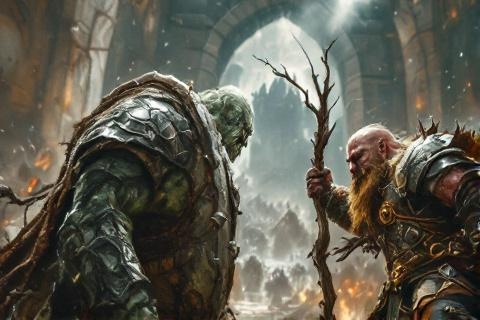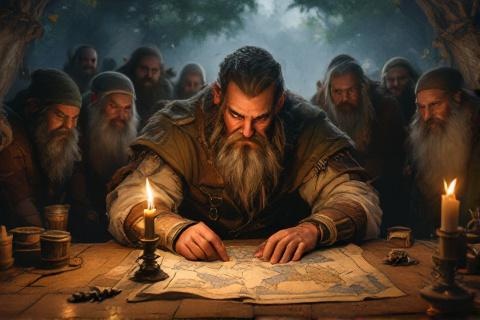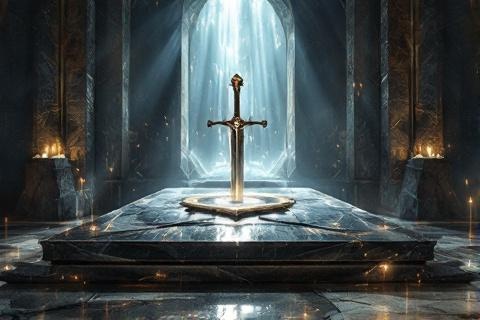
Thorin Oakenshield: The Heir of Erebor
Leader of the Dwarves' Quest
Royal Heritage and Early Years

Thorin II, later known as Oakenshield, entered the world in 2746 of the Third
Age into the prestigious royal line of Durin the Deathless.
Born during a time of unprecedented prosperity for the dwarves of
Erebor, he represented the continuation of one of
Middle-earth's most ancient and noble bloodlines.
As the grandson of the mighty King Thrór and son of Prince Thráin II, Thorin was
raised with the knowledge that he would one day inherit the throne of the Lonely
Mountain. His upbringing focused on the principles of leadership, warfare, and
the ancestral crafts of his people, preparing him for his future role as King
under the Mountain.
Thorin's early years in Erebor were marked by the kingdom's golden age, where
the dwarves' craftsmanship and mining expertise brought
unprecedented wealth to the realm. The young prince witnessed the greatness of
his grandfather's kingdom, with its vast halls filled with treasures, and
learned the arts of metalworking and stonecraft that were the pride of his
people.
In 2770 of the Third Age, Thorin experienced the catastrophic arrival of Smaug
the Golden, one of the last great dragons of
Middle-earth. The young dwarf prince, barely twenty-four years old at the time,
watched helplessly as the dragon decimated the kingdom's defenses and drove his
people from their ancestral home, an event that would shape his destiny and fuel
his lifelong quest for restoration.
Life in Exile
In the aftermath of Smaug's devastating attack, Thorin demonstrated remarkable
leadership by helping guide the survivors of Erebor to safety. Though young by
dwarvish standards, he assisted his grandfather and father in organizing the
evacuation, ensuring that as many of their people as possible escaped the
dragon's wrath.
The displaced dwarves of Erebor eventually found refuge in the Blue Mountains,
far to the west of their former home. Under Thorin's guidance, they established
new settlements in Ered Luin, though these dwellings were
modest compared to the splendor of their lost kingdom.
To support his displaced people, Thorin took up work as a blacksmith in the
settlements of Men, setting aside his royal pride to ensure his
people's survival. His craft earned him respect among Men and provided necessary
resources for the exiled dwarves, though the work was far beneath his royal
status.
In the Blue Mountains, Thorin helped establish a new home that, while
comfortable, served as a constant reminder of what they had lost. The dwellings
they built were practical rather than grand, and though they prospered through
trade and craftsmanship, their wealth never approached the magnificence of
Erebor.
The Making of Oakenshield

Thorin's most renowned deed in battle came during the War of the Dwarves and
Orcs, specifically at the Battle of Azanulbizar in 2799 T.A. This terrible
conflict, which culminated in the battle before the eastern gates of
Moria, would earn him the name by which he would be known
throughout Middle-earth.
During the heat of battle, when his shield was cloven, Thorin grabbed an oak
branch from a nearby tree to defend himself. He wielded this makeshift shield
with such effectiveness that it became legendary, earning him the epithet
'Oakenshield' which he carried proudly for the rest of his life.
In this same battle, Thorin faced the dreaded Azog, the Pale Orc
who had slain his grandfather Thrór. In single combat, Thorin avenged his
grandfather's death by defeating Azog, dealing him what was believed to be a
mortal wound, though unknown to Thorin, the great Orc would survive.
Throughout the battle, Thorin displayed exceptional courage and tactical
prowess, rallying the dwarven forces even as their casualties mounted. His
actions during this conflict earned him the deep respect and loyalty of his
people, cementing his position as their leader in exile.
Physical Appearance and Character

Despite years of exile and hardship, Thorin maintained the bearing and dignity
of a king of Durin's line. His presence commanded respect
wherever he went, and even those who did not know his heritage could sense his
noble lineage in his proud demeanor and regal bearing.
Thorin's appearance reflected his royal heritage, with his dark hair beginning
to show streams of silver that added to his distinguished look. His long forked
beard, characteristic of dwarf lords, was carefully maintained and spoke of his
adherence to dwarven traditions and customs.
In his travels and adventures, Thorin was known for wearing a distinctive
sky-blue hood adorned with a long silver tassel, a garment that became one of
his identifying features. This choice of attire, while practical for traveling,
maintained a touch of the nobility that was his birthright.
Among his prized possessions were an ornate sword and a golden harp, both of
which he carried with him in his wanderings. The harp revealed a lesser-known
side of his character, as he was skilled in music and song, often playing and
singing of the glory of Erebor and his people's heritage.
Leadership Style and Personality
As a leader, Thorin embodied the fierce pride and unwavering honor
characteristic of the line of Durin. His decisions were guided by a strong moral
compass and an unshakeable commitment to his people's welfare, though these
noble qualities were sometimes overshadowed by his more rigid traits.
Thorin's diplomatic skills were evident in his ability to forge alliances and
command respect from both dwarves and other races. His warrior prowess, honed
through years of battle and hardship, made him a formidable opponent and a
respected military leader among his people.
The responsibility of leading his displaced people and maintaining hope for
their future weighed heavily upon Thorin. He carried not only the practical
burdens of leadership but also the emotional weight of his people's expectations
and the memory of their lost homeland.
While Thorin's strong will and determination were among his greatest assets,
these qualities sometimes manifested as stubbornness and excessive pride. His
unwavering nature, while admirable in many situations, could lead to
inflexibility and difficulty in accepting alternate viewpoints or compromising
when necessary.
The Quest for Erebor

In 2941 of the Third Age, Thorin assembled a company of twelve trusted dwarves,
each chosen for their loyalty and various skills. The addition of Bilbo
Baggins as their burglar, on the recommendation of
Gandalf the Grey, would prove crucial to their quest
despite Thorin's initial skepticism.
The goal of reclaiming the Lonely Mountain from Smaug seemed impossible to many,
yet Thorin's unwavering resolve inspired his companions to join this perilous
venture. His determination never wavered, even in the face of seemingly
insurmountable obstacles and numerous setbacks.
Among Thorin's most valuable possessions were the map and key to Erebor's secret
door, given to him by his father Thráin before his disappearance. These
artifacts provided the only known way to enter the mountain without alerting
Smaug, and Thorin guarded them carefully throughout their journey.
Throughout their quest, Thorin demonstrated remarkable resilience and
leadership, maintaining the company's focus and determination despite countless
challenges. From trolls to goblins, from
Mirkwood's dangers to the political complexities they
encountered, he guided his company with unwavering purpose.
Legacy and Influence

Thorin's legacy endures as one of the most significant figures in dwarven
history, remembered as the king who dared to reclaim Erebor from the dragon
Smaug. His quest, though costly, resulted in the restoration of the Kingdom
under the Mountain and the return of his people to their ancestral home.
The dwarves of the Blue Mountains rallied behind Thorin's cause, and his quest
served to unite the scattered dwarven communities. His leadership during this
period demonstrated the strength and resilience of Durin's folk, even in their
darkest hours.
Future generations of dwarves would look to Thorin's example as a source of
inspiration and pride. His determination, courage, and ultimate sacrifice in
defense of his homeland became a central part of dwarven lore, inspiring
countless tales and songs.
The story of Thorin Oakenshield became one of the great tales of the Third Age,
remembered alongside other legendary narratives of Middle-earth. His quest to
reclaim Erebor, chronicled in the Red Book of Westmarch, stands as a testament
to the enduring spirit of the dwarves and their unwavering devotion to their
ancient homes.
